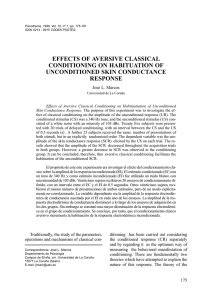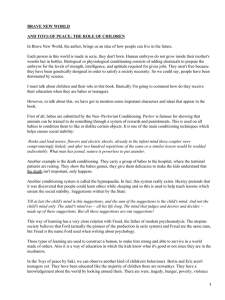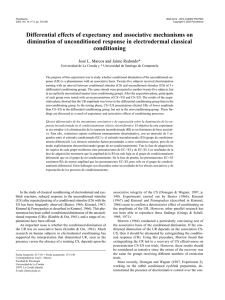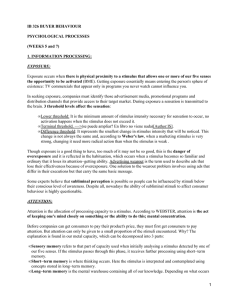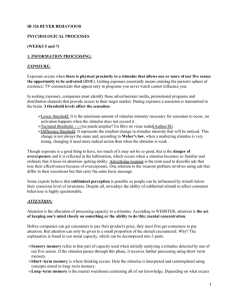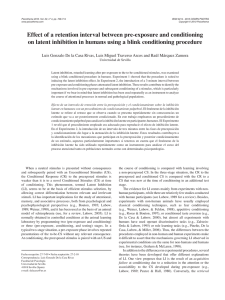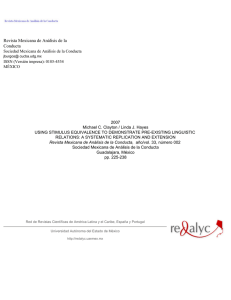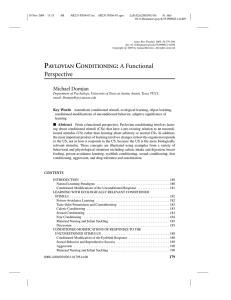Transfer of Latent Inhibition of Aversively Conditioned
Anuncio
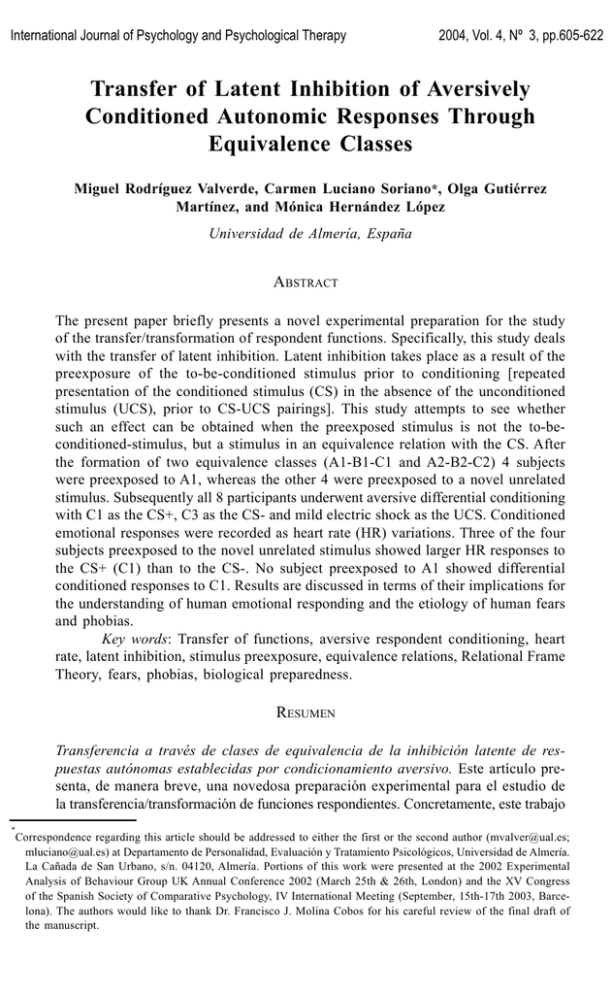
International Journal of Psychology and Psychological Therapy 2004, Vol. 4, Nº 3, pp.605-622 Transfer of Latent Inhibition of Aversively Conditioned Autonomic Responses Through Equivalence Classes Miguel Rodríguez Valverde, Carmen Luciano Soriano*, Olga Gutiérrez Martínez, and Mónica Hernández López Universidad de Almería, España ABSTRACT The present paper briefly presents a novel experimental preparation for the study of the transfer/transformation of respondent functions. Specifically, this study deals with the transfer of latent inhibition. Latent inhibition takes place as a result of the preexposure of the to-be-conditioned stimulus prior to conditioning [repeated presentation of the conditioned stimulus (CS) in the absence of the unconditioned stimulus (UCS), prior to CS-UCS pairings]. This study attempts to see whether such an effect can be obtained when the preexposed stimulus is not the to-beconditioned-stimulus, but a stimulus in an equivalence relation with the CS. After the formation of two equivalence classes (A1-B1-C1 and A2-B2-C2) 4 subjects were preexposed to A1, whereas the other 4 were preexposed to a novel unrelated stimulus. Subsequently all 8 participants underwent aversive differential conditioning with C1 as the CS+, C3 as the CS- and mild electric shock as the UCS. Conditioned emotional responses were recorded as heart rate (HR) variations. Three of the four subjects preexposed to the novel unrelated stimulus showed larger HR responses to the CS+ (C1) than to the CS-. No subject preexposed to A1 showed differential conditioned responses to C1. Results are discussed in terms of their implications for the understanding of human emotional responding and the etiology of human fears and phobias. Key words: Transfer of functions, aversive respondent conditioning, heart rate, latent inhibition, stimulus preexposure, equivalence relations, Relational Frame Theory, fears, phobias, biological preparedness. RESUMEN Transferencia a través de clases de equivalencia de la inhibición latente de respuestas autónomas establecidas por condicionamiento aversivo. Este artículo presenta, de manera breve, una novedosa preparación experimental para el estudio de la transferencia/transformación de funciones respondientes. Concretamente, este trabajo * Correspondence regarding this article should be addressed to either the first or the second author (mvalver@ual.es; mluciano@ual.es) at Departamento de Personalidad, Evaluación y Tratamiento Psicológicos, Universidad de Almería. La Cañada de San Urbano, s/n. 04120, Almería. Portions of this work were presented at the 2002 Experimental Analysis of Behaviour Group UK Annual Conference 2002 (March 25th & 26th, London) and the XV Congress of the Spanish Society of Comparative Psychology, IV International Meeting (September, 15th-17th 2003, Barcelona). The authors would like to thank Dr. Francisco J. Molina Cobos for his careful review of the final draft of the manuscript. 606 RODRÍGUEZ, LUCIANO, GUTIÉRREZ AND HERNÁNDEZ se centra en el análisis de la transferencia de la inhibición latente (IL). Este fenómeno es resultado de la preexposición del estímulo a condicionar de manera previa a una fase de condicionamiento [presentación repetida del estímulo condicionado (EC) sin el estímulo incondicionado (EI) antes de cualquier emparejamiento ECEI]. Este estudio pretende ver si este efecto se produce cuando el estímulo preexpuesto no es el estímulo a condicionar, sino un estímulo en relación de equivalencia con el EC. Tras la formación de dos clases de equivalencia (A1-B1-C1; A2-B2-C2) 4 sujetos fueron sometidos a la presentación repetida del estímulo A1, mientras que otros 4 sujetos fueron preexpuestos a un estímulo novedoso y no relacionado con ninguna de las clases. Tras esto, los 8 sujetos pasaron por un procedimiento de condicionamiento diferencial aversivo con C1 como EC+, C3 como EC- y con una descarga eléctrica de intensidad moderada como EI. Se midieron las respuestas emocionales condicionadas como variaciones de la tasa cardiaca (TC). Tres de los cuatro sujetos que pasaron por la preexposición con el estímulo no relacionado con el EC+ dieron muestras de condicionamiento (mayores respuestas de tasa cardiaca ante el EC+ que ante el EC-) mientras que ningún sujeto preexpuesto a A1 dio muestras de respuestas condicionadas diferenciales al EC+. Los resultados se discuten con respecto a sus implicaciones para la comprensión del comportamiento emocional y la etiología de los miedos y las fobias en humanos. Palabras clave: Transferencia de funciones, condicionamiento respondiente aversivo, tasa cardiaca, inhibición latente, preexposición a estímulos, relaciones de equivalencia, Teoría de los Marcos Relacionales, miedos, fobias, preparación biológica. The transfer/transformation of aversively conditioned respondents is an area of research with wide implications both at a basic and an applied level. From the point of view of Relational Frame Theory (RFT: see Hayes, Barnes-Holmes, & Roche, 2001), this verbal process may explain the emergence of emotional reactions to events and situations for which a history of direct traumatic conditioning is absent, such as the hyperarousal in posttraumatic stress disorder, which often extends to situations that bear no formal similarity with the original traumagenic setting (Friman, Hayes, & Wilson, 1998). These verbal processes extend the role of both operant and respondent learning processes in the etiology and maintenance of anxiety disorders beyond previous traditional preparations that involve pairings between nonverbal neutral stimuli and nonverbal unconditional stimuli (Forsyth, 2000). For instance, in a recent introductory paper to RFT (Blackledge, 2003) a widely-known cognitive model of fear learning (Lang’s fear network: Lang, 1985) is reconceptualized in terms of arbitrarily applicable relational responding, involving several examples of transfer/transformation of autonomic activation respondents (see Blackledge, 2003, pp. 421-423). However, despite the obvious relevance that this phenomenon has for a behavioranalytic account of human emotional responding, research on this issue has been scarce to date. A few studies have shown the transfer of respondent elicitation and extinction of autonomic arousal responses. The first study in this area, by Dougher, Markham, Augustson, Greenway, and Wulfert (1994), showed the transfer of respondent elicitation © Intern. Jour. Psych. Psychol. Ther. http://www.ijpsy.com TRANSFER OF LATENT INHIBITION 607 and extinction among members of an equivalence class employing a differential aversive conditioning procedure. A similar transfer effect was obtained by these authors by using compound, rather than single stimuli as members of the relational networks trained and tested (Augustson, Dougher, & Markham, 2000; Markham, Dougher, & Augustson, 2002). Consistent with these results, the transfer of avoidance evoking functions (Augustson & Dougher, 1997) has been obtained as well with single stimuli and a conditioning procedure very similar to the one employed in Dougher et al.’s (1994). Another two studies (Roche & Barnes, 1997; Roche, Barnes-Holmes, Barnes-Holmes, Smeets, & McGeady, 2000) have analyzed the transformation of autonomic responses of sexual activation. Although these studies are not specifically focused in the establishment of aversive emotional reactions, they have obtained both the transfer of respondently conditioned sexual arousal (as measured by a decrease in skin resistance) through members of an equivalence class, and the transformation of autonomic sexual responses in accordance with arbitrary relations other than equivalence (sameness and opposition), which extends the original findings by Dougher et al. (1994). Altogether these studies provide empirical data to explain how some stimuli might come to elicit anxiety and avoidance responses without a direct history of pairing with aversive events (i.e. without direct trauma) and, consequently, constitute a plausible argument in support of behavioral models of the etiology of fears and phobias (Forsyth, 2000). Behavioral models have traditionally been criticised in terms of the absence of conditioning histories for many clients suffering from anxiety disorders (Lazarus, 1984; Rachman, 1977). It has been argued that human fears need not involve a traumatic history of aversive conditioning, and several theorists have appealed to phylogeny, either as a substitute for learning processes (see Menzies & Clarke, 1995, for a non-associative account of fears and phobias) or as a biological constraint to the scope of those processes (biological preparedness, see Öhman & Mineka, 2001; Seligman, 1971). A criticism frequently made by the latter is that of the selectivity of fears and phobias, that is, the fact that fears of certain stimuli (snakes, dogs, spiders) are much more common than others (Seligman, 1971; Zafiropolou & McPherson, 1986). These differences in the incidence and prevalence of certain fears are supposed to be due to differences in the readiness with which an association with an aversive event can be learned (i.e. fear-relevant selective associations: Seligman, 1970). A widely accepted explanation of these phenomena, which is in line with more general explanations of selective associations (García & Koelling, 1966; Seligman, 1970) is that of biological preparedness, by which certain stimuli are supposed to be phylogenically prepared to be more easily conditioned to elicit fear responses than others (Seligman, 1971). This preparedness is due to the evolutionary survival value that this kind of learning was supposed to have for our ancestors, allowing them to readily avoid certain perils. Many explicative models of fears and phobias have adopted some sort of biological preparedness to account for differences in conditionability (Eysenck, 1979; Öhman & Mineka, 2001). A behavior-analytic position is not necessarily at odds with considering a role for phylogenical influences in learning (Catania, 1998; Plaud, 1995; Skinner, 1966), however from this point of view appealing to phylogeny as an explanatory variable is completely unjustified when the behavior under analysis can be accounted for by http://www.ijpsy.com © Intern. Jour. Psych. Psychol. Ther. 608 RODRÍGUEZ, LUCIANO, GUTIÉRREZ AND HERNÁNDEZ ontogenical contingencies (i.e. events taking place during the individual organism’s lifetime). Although the available evidence from research in derived relational responding (e.g. Dougher et al., 1994; Roche & Barnes, 1997) together with evidence from prior studies on semantic conditioning (see Forsyth & Eifert, 1996), provide a promising avenue of empirical research on the etiology of anxiety disorders, it seems most convenient to replicate and extend the few existing studies on transfer and transformation of respondents. According to this, the present study constitutes an attempt to extend on existing research on the basic processes of transfer of functions and respondent conditioning. Specifically, it is an attempt to experimentally obtain and analyze the transfer of latent inhibition (LI) of heart-rate conditioning in accordance with equivalence relations. LI is defined as the retardation in conditioning observed when a stimulus is preexposed prior to the acquisition of conditioning (Lubow, 1973). Preexposure refers to the fact that the stimulus is repeatedly presented alone before being consistently paired with the unconditioned stimulus (UCS). LI has been studied in close relation to attentional processes both with animals (see Lubow, 1989) and humans (see Lubow & Gewirtz, 1995) and it recently has become one of the most important experimental paradigms in the study of attention deficits in schizophrenia (e.g. Baruch, Hemsley, & Gray, 1988). Nevertheless, this phenomenon has been presented as an ontogeny-based behavioral alternative to explain fear-relevant selective associations (and hence the selectivity of fears and phobias) from a direct-contingency approach (Fernández & Luciano, 1992a,b; Levis, 1979; Lubow, 1998). The idea is that repeated safe (nontraumatic) exposure to common events and situations in our cultural community will retard or preclude successive aversive conditioning of those events as fear-relevant cues or phobic stimuli (Ayres, 1998; Levis, 1979; Levis & Malloy, 1982; Lubow, 1998), even in spite of their direct pairing with an aversive event. Conversely, stimuli that are supposed to be biologically prepared for fear conditioning (e.g. snakes, spiders, etc.) would have a much more reduced history of safe presentation within the cultural community, rather their history might be more determined by certain culturally established negative connotations (read negative verbal functions; see Fernández & Luciano, 1992b). LI in humans has been obtained with several experimental preparations (for a recent review see Daza, López, & Álvarez, 2002), including preparations of respondent conditioning of autonomic activation responses (Björkstrand, 1990; Booth, Siddle, & Bond, 1989; Lipp & Vaitl, 1992; Lipp, Siddle, & Vaitl, 1992; Siddle, Remington, & Churchill, 1985). Although these studies have mainly employed electrodermal activity as a dependent variable, the one by Lipp, Siddle, and Vaitl (1992) also measured cardiovascular activity, obtaining very good results with heart-rate measures. These findings, together with the ones on the transfer of respondents, constitute the empirical basis for a novel approach to the study of LI in humans, as well as for an extension of the analysis of human emotional behavior in terms of derived relational responding. The current study is the first experimental attempt to test whether LI can transfer/transform in accordance with arbitrarily established stimulus relations. Specifically, it is a preliminary attempt to see if LI of heart-rate conditioning would transfer across the members of an equivalence class. Such a finding would have important implications © Intern. Jour. Psych. Psychol. Ther. http://www.ijpsy.com TRANSFER OF LATENT INHIBITION 609 for a behavioral account of fears and phobias, as it might serve to explain why it is more difficult to get conditioning of emotional responses to some stimuli than to others, without appealing to phylogeny or to a direct history of contingencies with the stimuli concerned. It would be especially relevant for human research on LI, in the sense that LI is a phenomenon which is supposed to be stimulus-specific (Lubow & Gewirtz, 1995), that is, preexposure to any stimulus is not sufficient to obtain a subsequent retardation or preclusion of conditioning to a specific conditional stimulus (CS). The preexposed stimulus should be the same one to be conditioned in a later phase, or be physically similar to it (see Siegel, 1969, for an example of stimulus generalization of LI in animals). However, the present study analyzes the LI effect when the preexposed stimulus is not the same one to be conditioned, but a different stimulus in an equivalence relation with the to-be-conditioned stimulus. This preparation considerably broadens the individual history of interactions that may yield the LI effect, as well as it extends existing research on the transfer of aversively established respondents (e.g. Dougher et al., 1994), both by employing a different autonomic response (heart-rate) as dependent variable and by going beyond respondent elicitation and extinction. This study is a preliminary attempt to observe this phenomenon and establish an experimental paradigm for further studies. To achieve the goal of this experiment, all the eight participants were first taught two three-member equivalence classes. Half of the participants were then preexposed to a stimulus in an equivalence relation to the positive conditional stimulus (CS+) to be employed later in the conditioning task, whereas the other half were preexposed to a novel stimulus (unrelated to the CS+), serving as a control condition for the LI effect. A transfer of LI would be expected as a retardation or preclusion of the conditioning effect (i.e. no heart-rate differential responses to the CS+ as compared to the CS- on a within-subject measure). METHOD Subjects Eight undergraduate students (five male, three female) with ages between 19 and 25 participated in this study. They were recruited through in-class announcements and personal contacts, to volunteer for an experimental study on human learning, and were told that their participation could be very helpful in order to achieve a better understanding of learning processes, and hence help people with learning disabilities and psychological disorders. They did not receive any material compensation for participation. Before entering the experimental session they received an explanation of the general procedures and signed a statement of informed consent, acknowledging that the features of the experiment had been explained and that they did not suffer from any cardiovascular problems. Setting, stimuli and materials All sessions were conducted in an experimental room equipped with a one-way http://www.ijpsy.com © Intern. Jour. Psych. Psychol. Ther. 610 RODRÍGUEZ, LUCIANO, GUTIÉRREZ AND HERNÁNDEZ observation mirror. Subjects were seated in a comfortable armchair at a table. An Apple Macintosh Power-PC computer was utilized to present all stimuli and record performance data. Both experimental tasks (formation of equivalence classes and classical conditioning) were programmed with PsyScope, a software package designed for the preparation of computer controlled psychological experiments (Cohen, McWhinney, Flatt & Provost, 1993; Roche, Stewart & Barnes-Holmes, 1999). Ten nonsense syllables (CUG, MEL, PAF, MAU, ZID, HOL, COL, LEB, KET and SIP) were used as stimuli. The first nine of them were labelled A1, A2, A3, B1, B2, B3, C1, C2 and C3 respectively, for experimental purposes, but subjects were not exposed to these alphanumerical labels. The last one (SIP) was used as a non-related stimulus in order to serve as a control of the LI effect (see Design). Mild electric shock was employed as unconditioned stimulus (UCS). All shocks were 50-80 volts in amplitude and 50 ms in duration and were provided by a variableamplitude shock generator (Lafayette Instruments 82415 IS). Shocks were delivered to the volar surface of the right forearm of each subject through a bar electrode fastened to it with surgical tape. Additionally, participants were isolated from external noises during the conditioning procedures by the presentation of white noise through stereo headphones. Cardiac activity was recorded through BIOPAC ELS503 pre-gelled electrodes connected to a BIOPAC ECG100A amplifier. The amplifier was connected to an Apple Macintosh computer through an MP100W A/D converter (BIOPAC Instruments). Experimental Design Subjects were randomly assigned to one of two experimental conditions (four subjects per condition) designated as RELATED and NON-RELATED, according to a between-subject design with replications. The study consisted of three phases: (1) formation Table 1. Schematic representation of the experimental design: First, Phase 1 (formation of equivalence classes); second Phase 2 (pre-exposure) with 4 subjects exposed to A1 (in an equivalence relation with the CS+, C1) and another 4 subjects exposed to a stimulus non related to the CS+; finally, Phase 3 (conditioning phase with acquisition and extinction trials). Phase 1: Equivalence Classes Formation Class A1-B1-C1 Class A2-B2-C2 Phase 2: Preexposure Phase 3: Conditioning To a RELATED stimulus A1: (20 trials) 4 Ss. ACQUISITION 10 trials C1 (CS+) + UCS 10 trials C3 (CS-) 8 Ss. (all participants) To a NON-RELATED stimulus SIP: (20 trials) 4 Ss. EXTINCTION 10 trials C1 (CS+) 10 trials C3 (CS-) 8 Ss. (all participants) © Intern. Jour. Psych. Psychol. Ther. http://www.ijpsy.com TRANSFER OF LATENT INHIBITION 611 of equivalence classes, (2) pre-exposure and (3) classical conditioning. Phases 1 and 3 were identical for both experimental conditions, whereas the second phase involved an experimental manipulation between subjects (see Table 1). In Phase 1, all subjects were trained and tested for the formation of two threemember equivalence classes (A1-B1-C1 and A2-B2-C2) by means of a matching-tosample procedure. A third set of stimuli (A3, B3, C3) served as incorrect comparisons. Phase 2 consisted of twenty unreinforced presentations of either stimulus A1 (RELATED: subjects 1-4) or syllable SIP (NON-RELATED: subjects 5-8). In Phase 3, all subjects went through a differential aversive conditioning procedure with C1 as the positive conditioned stimulus (CS+), with C3 as the negative conditioned stimulus (CS-), and mild electric shock as the unconditioned stimulus (UCS). The differential conditioning procedure allows for the analysis of conditioning effects on an individual basis. For each subject, a conditioning effect is assumed to happen if they show a differential response pattern to the CS+ as opposed to the CS-. Specifically, responses to the CS+ should be larger than responses to the CS- in order to assume such an effect (because the CS+ was consistently paired with the UCS during the conditioning phase). Therefore, even though the study is designed according to a between-subject methodology, the individual analysis of differential response patterns to each CS provides the basic index of conditioning for each participant in both conditions, which is most coherent for a functional analysis, instead of average group measures (Dougher & Hayes, 2000; Luciano, 1989; Sidman, 1960). Procedure All participants went through the study individually in a single experimental session. Before beginning the session, the experimenter explained the general procedures to the participant concerned, and they signed the statement of informed consent. Participants were explicitly told that they were free to discontinue participation at any time during the study if they so wished. Then they entered the experimental room and the session began. Phase 1: Formation of equivalence classes. Subjects were trained in four conditional discriminations (A1-B1, A2-B2, B1-C1, B2-C2) by means of matching-to-sample procedures with three comparisons. Subjects were then tested for the emergence of two equivalence classes (A1-B1-C1 and A2-B2-C2). A third set of stimuli (A3, B3, C3) served as incorrect comparisons for both classes, therefore no specific relations among these stimuli were trained nor tested. Training trials were conducted as follows: a sample stimulus appeared at the top centre of the screen, and one second later, three comparisons appeared in a row at the bottom of the screen (left, centre and right, respectively). Subjects could choose any comparison by pressing either the Z key for the comparison on the left, the V key for the comparison in the centre, or the M key for the comparison on the right. When subjects pressed one of the keys (either Z, V or M), the screen cleared, and both written and spoken feedback were provided. When participants responded in accordance with the conditional relations to be trained, the word CORRECT appeared at the centre of the screen for 1.5 seconds, while a recorded http://www.ijpsy.com © Intern. Jour. Psych. Psychol. Ther. 612 RODRÍGUEZ, LUCIANO, GUTIÉRREZ AND HERNÁNDEZ female voice simultaneously gave the same feedback through the computer speakers. When subjects did not respond in accordance to the relations to be trained, the word WRONG was presented in an identical way. After that, the screen cleared again and a new trial started. Test trials were conducted in the same way, with the exception that neither written nor spoken feedback was provided. The position of each comparison was counterbalanced across trials. Training and test trials were presented in blocks according to the following sequence. First, each participant read a set of instructions (see Appendix) about the experimental task. They were told that the purpose of the task was to relate syllables, and that they had to obtain as many correct responses as possible. After that, they were presented with a training block for the A-B relation. Six A1-B1 trials and six A2-B2 trials appeared sequentially, and then 24 trials (12 of each kind) appeared in random order. Subjects had to complete the last twelve trials without errors as a mastery criterion to pass this block. Next, participants read another set of instructions (see Appendix) and completed a test block for the symmetrical relation B-A with 20 trials in random order. Subjects had to show an errorless performance in order to pass to the next block. Then, they went through another training block, identical to the first one, but for the B-C relation. After that, another symmetry test block, but for the C-B relation this time, was presented. The next block was another training block of all explicitly trained relations (A-B and B-C). It consisted of 60 trials (15 per relation) in random order. The criterion for this block was a maximum of one error throughout the whole block. All symmetry relations were re-tested in the next block, consisting of 28 trials (7 per relation) in random order. The criterion for passing to the next and final block was 100% correct. Before this last block was presented, subjects had to read again the second set of instructions (Appendix). Participants were then tested for all derived relations (both mutually entailed –symmetry- and combinatorially entailed –transitivity) through 56 trials (7 per relation) presented in random order. They had to show an errorless performance to pass this block. When participants reached the mastery criterion for each block they passed to the next scheduled block. If they failed to pass a training block, it was re-trained until they reached the mastery criterion. When they failed to pass a test block, the immediately prior training block was re-trained, with the exception of the two last test blocks. In these cases, when subjects had a maximum of one error per relation they were re-tested. When the number of errors was higher, they were retrained. Subjects were exposed to each block a maximum of three times. They were dropped from the study if they did not reach training and test criteria within these parameters. Phases 2 (Pre-exposure) and 3 (Classical Conditioning). After the formation of equivalence classes, subjects were requested to leave the experimental room for a five minute break. When they entered the room again they were told that the next part of the study, in which they would be shocked at times, was to begin. Then they were attached the recording electrodes according to ECG lead II. The negative electrode was placed on the volar surface of the right wrist, the positive one on the inner side of the left ankle, and the ground electrode on the inner side of the right ankle. After that, the stimulating electrode (the one through which electric shocks were delivered) was fastened © Intern. Jour. Psych. Psychol. Ther. http://www.ijpsy.com TRANSFER OF LATENT INHIBITION 613 to the right forearm. Then, the level of voltage of the shocks to be delivered was established. Participants were told that for the purpose of the experiment, shocks should be definitely uncomfortable but not painful. The experimenter then administered several test shocks with increasing voltage, until the participant chose the level they considered uncomfortable. Once such a level was selected, the experimenter told the subjects that their task was to look at the screen and pay attention, and to stay as still and quiet as possible. They were told that the screen would remain blank, and that sometimes a syllable would appear. They were also told that the electric shock would sometimes appear and that the whole duration of that phase would be about half an hour. The experimenter then left the room, and after a five-minute period for the habituation of autonomic activity, the experimental task began. Phases 2 and 3 were conducted consecutively without pauses, as part of the same experimental task. Phase 2 (pre-exposure) consisted of the presentation of 20 consecutive trials in which a syllable appeared on the screen for 8 s. Subjects in condition RELATED were presented with the syllable CUG (stimulus A1), whereas subjects in condition NON-RELATED were presented with SIP (irrelevant stimulus). Inter-trial interval (ITI) was 15 s, during which the screen remained blank. After pre-exposure, all participants went through the same classical conditioning task (see Table 1, Phase 3). They were exposed to an 8 second-delay differential conditioning procedure, both with acquisition and extinction trials. During acquisition, syllable PAF (stimulus C1) served as the CS+, and was paired for 10 trials with the UCS (electric shock). The CS+ appeared on the screen for 8 seconds. The onset of the UCS was simultaneous to the offset of the CS+. Syllable KET (stimulus C3) served as the CS-, and it was presented alone for 10 trials. Trials of both types appeared intermixed in a random order, one at a time, with the constraint that no more than two trials of the same sort appeared consecutive to each other. The ITI was variable with an average of 35 seconds, in order to avoid temporal conditioning effects. Extinction trials commenced right after all acquisition trials had been presented. They were presented identically to acquisition trials, with the exception that the UCS never appeared. Both the CS+ and the CS- were presented alone for ten trials each, intermixed in random order (no more than two consecutive trials of the same sort) and with an average ITI of 35 s. Once the conditioning task was over, the experiment finished. Response quantification The raw ECG was recorded and filtered in order to obtain a clearer R-wave. Heart rate (HR) was calculated online by the computer on the basis of the inter-peak interval for the R-wave. The maximum decrease in HR was calculated for each CS interval (8 seconds). The minimum HR score in the interval was subtracted from a baseline HR value obtained for each trial by averaging HR during the 2 second interval immediately prior to each CS presentation. Whenever no decrease was found for the interval under analysis (i.e. data just showed an increase in HR) variations in HR were not quantified but were read as having a value of zero for that trial (zero values were http://www.ijpsy.com © Intern. Jour. Psych. Psychol. Ther. 614 RODRÍGUEZ, LUCIANO, GUTIÉRREZ AND HERNÁNDEZ included in all statistical analyses) on the basis of the approach taken by Roche & Barnes (1997) in their study on the transformation of respondent functions with electrodermal activity (see Roche & Barnes, 1997, p.278). This quantification applied to pre-exposure, acquisition, and extinction trials. It provides relevant information about anticipatory conditioned responses to each stimulus presented. Additionally, for extinction trials the maximum HR decrease was also calculated for the 7 second interval immediately following the CS offset, which may provide relevant information about conditioned responses to the UCS omission (Fernández & Luciano, 1992a). RESULTS Formation of equivalence classes Although with some variability in regard to the number of trials needed, all subjects reached training and test criteria for the formation of equivalence classes. Table 2 presents data for each subject and each type of training or test block. The number of correct trials per total trials in each block is presented, with the exception Table 2. Formation of equivalence classes: Correct responses per block. Data in bold characters indicate that the mastery criterion was reached for that block. Blocks of trials A-B training B-A Test B-C training C-B Test A-B/B-C training B-A/C-B Re-test B-A/C-B A-C/C-A Test 1 12/12 20/20 12/12 20/20 60/60 28/28 56/56 2 10/12 12/12 20/20 12/12 20/20 57/60 59/60 59/60 26/28 28/28 56/56 Subject 3 4 11/12 12/12 20/20 12/12 20/20 60/60 28/28 55/56 56/56 12/12 20/20 12/12 20/20 54/60 59/60 28/28 53/56 56/56 5 12/12 20/20 12/12 20/20 60/60 28/28 56/56 6 12/12 20/20 12/12 20/20 60/60 28/28 56/56 7 12/12 20/20 12/12 20/20 60/60 28/28 56/56 8 10/12 12/12 20/20 12/12 12/12 16/20 20/20 60/60 28/28 56/56 © Intern. Jour. Psych. Psychol. Ther. http://www.ijpsy.com TRANSFER OF LATENT INHIBITION 615 of A-B and B-C training blocks. For these blocks, data just include the last twelve trials (the mastery criterion for these blocks was established in regard to those trials). Given that each time participants failed to pass a test block they were retrained, some training blocks were presented several times for some participants, despite they had already reached the training criterion (see Table 2). Subjects 1, 5, 6 and 7 were the fastest in completing the equivalence tasks, as they just passed once per each block, reaching the mastery criteria with the minimum necessary trials. In contrast, subject 8 took the longest to complete the equivalence tasks, having to repeat at least once in four blocks. Preexposure and conditioning (transfer of LI) Before undertaking the description of results regarding the transfer of LI, we have to emphasize and recall that the transfer of LI should be observed either as a retardation or preclusion of the conditioning effect. That is, participants in condition RELATED should show little or no difference between their responses to the CS+ and the CS-, whereas participants in condition NON-RELATED should show the expectable conditioning effect of larger responses to the CS+ than to the CS-. Differential response patterns were calculated by averaging the maximum HR decrease per trial across trials for each subject. Figure 1 depicts the mean maximum HR decrease with both the CS+ and the CS- for all subjects and for each of the intervals analyzed. The upper graph shows average HR responses during the CS duration interval across acquisition trials, the middle graph shows the average HR responses during the same interval across extinction trials, and the lower graph shows average HR responses during the 7 s interval after CS offset across extinction trials (UCS omission responses). Visual inspection of data as well as statistical analysis was conducted. Three separate dependent t-tests were used for each subject to compare all HR responses to the CS+ with those to the CS- (one comparison for each of the three intervals). This test was chosen because it has been indicated as appropriate when successive experimental trials are assumed to be independent of each other (Box & Tiao, 1965; see Roche & Barnes, 1997). Significant differences (p<0.05) in these measures are marked with an asterisk in Figure 1. As shown in this graph, no participant in condition RELATED shows any significant difference in their differential responses to each CS, either visually or statistically, which is indicative of an absolute absence of conditioning effects. However, visual inspection shows that participants 5, 7 and 8 (all of them in condition NONRELATED) had larger responses to the CS+ than to the CS- in the three measures taken, although significant differences (indicated with asterisks) were only found for some of these measures. Significant differences appear for the three subjects in the form of larger UCS-omission responses to the CS+ than to the CS- for extinction trials during the 7 s interval post-CS offset (Figure 1, lower panel: subject 5: t=2.601, p<0.05; subject 7: t=2.385, p<0.05; subject 8: t=2.489, p<0.05). Additionally, subject 7 also shows significant differences for acquisition trials (Figure 1, upper panel: t=2.330, p<0.05), and subject 8 shows them for extinction trials during the CS duration interval (Figure 1, middle panel: t=2.542, p<0.05). http://www.ijpsy.com © Intern. Jour. Psych. Psychol. Ther. 616 RODRÍGUEZ, LUCIANO, GUTIÉRREZ AND HERNÁNDEZ Acquisition 15.0 CS+ RELATED CS+ NON-RELATED 12.5 * 10.0 7.5 CS+ CS- 5.0 2.5 0.0 1 2 3 4 5 6 7 8 Extinction 12.5 * 10.0 7.5 5.0 2.5 0.0 1 2 3 4 5 6 7 8 Extinction (UCS-omission responses) 12.5 * * * 10.0 7.5 5.0 2.5 0.0 1 2 3 4 5 6 7 8 Subjects Figure 1. Average HR responses (maximum HR decrease) per subject during the CS duration interval across aquisition and extinction trials. The lower panel presents responses across extinction trials during the 7 s interval following CS offset (UCS omission responses). Subjects 1 to 4 (condition RELATED) underwent preexposure to a stimulus in an equivalence relation with the CS+; subjects 5 to 8 (condition NON-RELATED) underwent preexposure to a stimulus unrelated to the CS+. © Intern. Jour. Psych. Psychol. Ther. http://www.ijpsy.com TRANSFER OF LATENT INHIBITION 617 DISCUSSION Both the visual inspection and the statistical analysis of the results show considerable variability. However, a tendency can be seen for subjects in condition NONRELATED for a bigger decrease in HR when presented with the CS+ than with the CS. Such a decrease is not evident for any subject in condition RELATED, whereas 3 out of 4 show it in condition NON-RELATED. This means that subjects in NON-RELATED show conditioning to a certain extent. These subjects were preexposed to a novel stimulus completely unrelated to any stimulus in the conditioning task. On the other hand, subjects in RELATED, who were preexposed to a stimulus in an equivalence relation with the to-be-conditioned stimulus, show no conditioning effects of any sort, which is indicative of the transfer of LI effect. However, these results should be taken cautiously. The main problem with them is that the conditioning effect is just partially evident, which questions the effectiveness of the procedure used to obtain conditioning. Conditioning effects are observed for three subjects out of four in NON_RELATED for one of the three intervals (UCSomission responses). For the remaining two intervals, although visual differences are evident, only one subject in each case shows evidence of conditioning as measured by the statistical analysis. There are several possible reasons for this. First, the HR conditioned response with long inter-stimulus intervals (ISIs) (5-10s) is quite complex and variable, and it largely depends on pre-stimulus HR levels (Öhman, Hamm, & Hughdal, 2000), as well as it has a natural variability mostly due to respiratory activity (sinus respiratory arrhythmia: see Brownley, Hurwitz, & Schneiderman, 2000; also see Marcos, 1997). Thus, although a decrease in HR -a conditioned cardiac deceleration- is expected as a conditioned response on the basis of prior studies (e.g. Lipp et al., 1992), both increases and decreases may be found within this sort of ISI. Specifically, a multiphasic cardiac response has been described by some authors with an 8 second ISI, with two deceleratory components (D1 and D2) and an acceleratory one (A) (see Öhman et al., 2000; Redondo, 2003). Given the preeminence of the deceleratory component, as well as previous experimental results (Lipp et al., 1992) and some pilot data, we focused in the cardiac deceleration as the response under analysis. An additional related issue comes from the fact that these studies normally use larger samples and present average data across groups, which necessarily precludes an individual analysis. Large samples and group methodology tend to yield softer curves by masking individual variability, thus making differences among groups more evident. However, in our opinion an attempt should be made to obtain a better within-subject control of this sort of responses, rather than masking the lack of experimental control with large samples and between-group statistical analyses. An alternative possibility is to work with other indices of autonomic arousal which are supposed to be less variable and less sensitive to pre-stimulus baseline levels, like electrodermal activity (Dougher et al., 1994; Öhman et al., 2000; Roche & Barnes, 1997) Besides the variable nature of the response, there are other features of the procedure employed that might account for the apparent weakness of the conditioning effect. For instance, all stimuli involved in the conditioning procedure had a history (formation of http://www.ijpsy.com © Intern. Jour. Psych. Psychol. Ther. 618 RODRÍGUEZ, LUCIANO, GUTIÉRREZ AND HERNÁNDEZ equivalence classes) which may have somehow functioned as a preexposure phase itself, hence making it more difficult to obtain the conditioning effect for subjects in either condition (a similar point was noted by Roche & Barnes, 1997 in regard to their conditioning results), regardless of the preexposed stimulus. A related point refers to the utilization of C1 as CS+ and C3 as CS-. Although both stimuli were employed in the formation of equivalence classes, they have different contingency histories in the sense that C3 was always used as an incorrect comparison along the formation of stimulus classes. The selection of C3 was never reinforced, nor did it serve as a sample in test trials. In contrast, C1 served both as a correct comparison and a sample (during test trials). It is unclear whether these historical differences between both stimuli might have influenced the conditioning process, but in order to avoid this possible source of variability, future studies should use CSs with more similar training histories (e.g. in this study, C2 could have been employed). Additionally, it has to be admitted that more control conditions are needed. At least, a group in which latent inhibition per se was tested (the stimulus which is preexposed would be the same one to be conditioned later), and another one to test for the differential transfer of the LI effect to the members of the same class, but not to the members of a different class. Moreover, further research could also test the transformation of LI in accordance with relational frames other than equivalence or coordination relations, such as difference or opposition. Nevertheless, although further research is needed, we think that the data presented here are indicative that the retardation in conditioning due to unreinforced preexposure, that is, LI, may be observed for stimuli which have not been directly preexposed, but which are part of a relational network with the preexposed stimulus. Furthermore, we think these data justify further research in this direction, pursuing a more strict experimental control of the conditions that might determine the occurrence of such a phenomenon. Further results indicative of the transfer of LI would posit interesting questions for current theories of LI in humans (Lubow & Gewirtz, 1995), such as to which extent LI can occur to novel elements of an arbitrary category (which have never undergone preexposure) as a result of preexposure to a small subset of elements in that category (see Lubow, 1998), whether the category be semantic or established in terms of explicit arbitrary relational training. Additionally, they shall offer further support for an RFT-based account of the selectivity of fears and phobias. Such an account places the emphasis on the personal history of the individual, both in direct and derived (verbal) terms, and it would constitute an empirically-based behavior-analytic alternative to either associative accounts that include some sort of biological preparedness (Öhman & Mineka, 2001; Seligman, 1971), accounts which overtly advocate a non-associative and genetically-based explanation of the etiology of fears and phobias (Menzies & Clarke, 1995), or cognitive accounts which rely on hypothetical explanatory constructs such as fear beliefs and expectancies (Lang, 1985; Davey, 1995). Obviously, much work remains to be done in the line of this very first study on the transfer of LI, to provide such conceptual approach with solid empirical underpinnings. © Intern. Jour. Psych. Psychol. Ther. http://www.ijpsy.com TRANSFER OF LATENT INHIBITION 619 REFERENCES Augustson, E.M. & Dougher, M.J. (1997). The transfer of avoidance evoking functions through stimulus equivalence classes. Journal of Behavior Therapy and Experimental Psychiatry, 28, 181-191. Augustson, E.M., Dougher, M.J., & Markham, M.R. (2000). Emergence of conditional stimulus relations and transfer of respondent eliciting functions among compound stimuli. The Psychological Record, 50, 745-770. Ayres, J. J. B. (1998). Fear conditioning and avoidance. In W. O’Donohue (Ed.), Learning and Behavior Therapy (pp. 122-145). Needham Heights, MA: Allyn and Bacon. Baruch, I., Hemsley, D.R., & Gray, J.A. (1988). Differential performance of acute and chronic schizophrenics in a latent inhibition task. Journal of Nervous and Mental Disease, 176, 598606. Björkstrand, P. (1990). Effects of conditioned stimulus pre-exposure on human electrodermal conditioning to fear-relevant and fear-irrelevant stimuli. Biological Psychology, 30, 35-50. Blackledge, J.T. (2003). An introduction to relational frame theory: basics and applications. The Behavior Analyst Today, 3, 421-433. Booth, M.L., Siddle, D.A.T. & Bond, N.W. (1989). Effects of conditioned stimulus fear-relevance and preexposure on expectancy and electrodermal measures of human Pavlovian conditioning. Psychophysiology, 26, 281-291. Box, G.E.P. & Tiao, G.C. (1965). A change in level of non-stationary time series. Biometrika, 52, 181192. Brownley, K.A., Hurwitz, B.E. & Schneiderman, N. (2000). Cardiovascular psychophysiology. In J.T. Cacioppo, L.G. Tassinary and G.G. Berntson (Eds.), Handbook of Psychophysiology, 2nd ed (pp. 224-264). New York: Cambridge University Press. Catania, A.C. (1998). Learning. Englewood Cliffs, NJ: Prentice Hall. Cohen, J.D., MacWhinney, B., Flatt, M., & Provost, J. (1993). PsyScope: An interactive graphical system for designing and controlling experiments in the psychology laboratory using Macintosh computers. Behavior Methods, Research, Instruments and Computers, 25, 257-271. Davey, G.C.L. (1995). Preparedness and phobias: Specific evolved associations or generalized expectancy bias? Behavioral and Brain Sciences, 18, 289-325. Daza, M.T., López, G., & Álvarez, R. (2002). Procedimientos experimentales en el estudio de la inhibición latente en humanos [Experimental procedures for the study of latent inhibition in humans]. International Journal of Psychology and Psychological Therapy, 2, 75-99. Dougher, M.J. & Hayes, S.C. (2000). Clinical behavior analysis. In M.J. Dougher (Ed.), Clinical Behavior Analysis (pp. 11-26). Reno, NV: Context Press. Dougher, M.J., Augustson, E.M., Markham, M.R., Greenway, D.E., & Wulfert, E. (1994). The transfer of respondent eliciting and extinction functions through stimulus equivalence classes. Journal of the Experimental Analysis of Behavior, 62, 331-351. Eysenck, H.J. (1979). The conditioning model of neurosis. Behavioral and Brain Sciences, 2, 155199. Fernández, A. & Luciano, M.C. (1992a). Condicionamiento electrodermal de estímulos ontogenéticamente preparados: un análogo de la selectividad de las fobias [Electrodermal conditioning of ontogenically prepared stimuli: an analogue of the selectivity of phobias]. Análisis y Modificación de Conducta, 59, 373-396. http://www.ijpsy.com © Intern. Jour. Psych. Psychol. Ther. 620 RODRÍGUEZ, LUCIANO, GUTIÉRREZ AND HERNÁNDEZ Fernández, A. & Luciano, M.C. (1992b). Limitaciones y problemas de la teoría de la preparación biológica de las fobias [Limitations and problems in the biological preparedness theory of phobias]. Análisis y Modificación de Conducta, 58, 204-230. Forsyth, J.P (2000). A process-oriented behavioral approach to the etiology, maintenance, and treatment of anxiety related disorders. In M.J. Dougher (Ed.), Clinical Behavior Analysis (pp. 153-180). Reno, NV: Context Press. Forsyth, J.P. & Eifert, G.H. (1996). The language of feeling and the feeling of anxiety: contributions of the behaviorisms toward understanding the function-altering effects of language. The Psychological Record, 46, 607-649. Friman, P.C., Hayes, S.C., & Wilson, K.G. (1998). Why behavior analysits should study emotion: the example of anxiety. Journal of Applied Behavior Analysis, 31, 137-156. García, J., & Koelling, R. (1966). Relation of cue to consequence in avoidance learning. Psychonomic Science, 4, 123-124. Hayes, S.C., Barnes-Holmes, D., & Roche, B. (2003). Relational Frame Theory: A Post Skinnerian Account of Human Language and Cognition. New York: Plenum Press. Lang, P. J. (1985). Cognition in emotion: Concept and action. In C. Izard & J. Kagan (eds.), Emotions, cognition, and behavior (pp. 192-226). New York: Cambridge University Press. Lazarus, A. (1984). On the primacy of cognition. American Psychologist, 39,124-129. Levis, D.J. (1979). A reconsideration of Eysenck’s model of neurosis. Behavioral and Brain Sciences, 2, 172-174. Levis, D.J. & Malloy, P.F. (1982). Research in infrahuman and human conditioning. En T. Wilson y C. Franks. (Eds.), Contemporary Behavior Therapy (pp. 65-118). New York: Guilford Press. Lipp, O., Siddle, D., & Vaitl, D. (1992). Latent inhibition in humans: single-cue conditioning revisited. Journal of Experimental Psychology: Animal Behavior Processes, 18, 115-125. Lubow, R.E. & Gewirtz, J.C. (1995). Latent inhibition in humans: Data, theory, and implications for schizophrenia. Psychological Bulletin, 117, 87-103. Lubow, R.E. (1973). Latent inhibition. Psychological Bulletin, 79, 398-407. Lubow, R.E. (1989). Latent inhibition and conditioned attention theory. Cambridge, England: Cambridge Unversity Press. Lubow, R.E. (1998). Latent inhibition and behavior pathology: Prophylactic and other possible efects of stimulus preexposure. In W. O’Donohue (Ed.), Learning and Behavior Therapy (pp. 107121). Needham Heights, MA: Allyn and Bacon. Luciano, M.C. (1989). Una aproximación conceptual y metodológica a las alteraciones conductuales en la infancia [A conceptual and methodological approach to child behavior disorders.]. Granada: SPUG. Marcos, J.L. (1997). Técnicas de condicionamiento humano. Madrid: Universitas. [Techniques in human conditioning.] Markham, M.R., Dougher, M.J. & Augustson, E.M. (2002). Transfer of operant discrimination and respondent elicitation via emergent relations of compound stimuli. The Psychological Record, 52, 325-350. Menzies, R.G. & Clarke, J.C. (1995). The etiology of phobias: a nonassociative account. Clinical Psychology Review, 15, 23-48. Ohman, A., Hamm, A., & Hugdahl, K. (2000). Cognition and the autonomic nervous system. Orienting, anticipation and conditioning. In J.T. Cacioppo, L.G. Tasinary and G. Bertson (Eds.), Handbook © Intern. Jour. Psych. Psychol. Ther. http://www.ijpsy.com TRANSFER OF LATENT INHIBITION 621 of Psychophysiology (pp. 533-575). New York: Cambridge University Press. Ohman, A. & Mineka, S. (2001). Fears, phobias and preparedness: Toward an evolved module of fear and fear learning. Psychological Review, 108, 483-522. Plaud, J.J. (1995). The generalized expectancy bias: An explanatory enigma. The Behavioral and Brain Sciences, 18, 311-312. Rachman, S. (1977). The conditioning theory of fear acquisition: a critical examination. Behaviour Research and Therapy, 15, 375-387. Redondo, J. (2003). Un programa BASIC para el cálculo y registro de puntuaciones diferenciales de tasa cardiaca. Psicológica, 24, 123-131. [A BASIC program for the calculation and recording of differential heart rate scores.] Roche, B. & Barnes, D. (1997). A transformation of respondently conditioned stimulus function in accordance with arbitrarily applicable relations. Journal of the Experimental Analysis of Behavior, 67, 275-301. Roche, B., Barnes-Holmes, D., Barnes-Holmes, Y., Smeets, P. M., & McGeady, S. (2000). Contextual control over the derived transformation of discriminative and sexual arousal functions. The Psychological Record, 50, 267-291. Roche, B., Stewart, I., & Barnes-Holmes, D. (1999). PsyScope: An easy-to-use graphical system for designing and controlling equivalence experiments. Experimental Analysis of Human Behavior Bulletin, 17, 5-7 Seligman, M.E.P. (1970). On the generality of the laws of learning. Psychological Review, 77, 406418. Seligman, M.E.P. (1971). Phobias and preparedness. Behavior Therapy, 2, 307-320. Siddle, D.A.T., Remington, B., & Churchill, M. (1985). Effects of conditioned stimulus preexposure on human electrodermal conditioning. Biological Psychology, 20, 113-127. Sidman, M. (1960). Tactics of scientific research. New York: Basic Books. Siegel, S. (1969). Generalization of latent inhibition. Journal of Comparative and Physiological Psychology, 69, 157-159. Skinner, B.F. (1966). The phylogeny and ontogeny of behavior. Science, 153, 1204-1213. Vaitl, D. & Lipp, O. (1997). Latent inhibition and autonomic responses: A psychophysiological approach. Behavioural Brain Research, 88, 85-93. Zafiropolou, M. & McPherson, F.M. (1986). Preparedness and the severity and outcome of clinical phobias. Behaviour Research and Therapy, 24, 221-222. Received October 13, 2004 Final acceptance October 30, 2004 http://www.ijpsy.com © Intern. Jour. Psych. Psychol. Ther. 622 RODRÍGUEZ, LUCIANO, GUTIÉRREZ AND HERNÁNDEZ APPENDIX: INSTRUCTIONS FOR THE FORMATION OF EQUIVALENCE CLASSES. 1st set of instructions: “The task you will participate in consists of relating syllables. Several syllables will appear on the screen, and you have to indicate which ones correspond to others: -a syllable (called sample) will appear in the top centre of the screen. -then three syllables (called comparisons) will appear at the bottom (one in the left side, one in the middle, and one in the right side). -you have to choose one of the comparisons and the computer will tell you whether your choice is correct or not. -to choose the comparison on your left press Z, to choose the comparison on the centre press V, and to choose the comparison on your right, press M. -there is only one possible correct response in each trial. -it is important to pay attention to the syllables on the screen, as you have to complete the task with the least possible mistakes.” 2nd set of instructions: “Now you are going to keep working in the same task. It is about relating the syllables on the screen. As we have seen before, each time you will have to choose the correct comparison for each sample. This time the computer won’t give you any feedback about your choices, but still there is one correct comparison per sample each time. Although the computer will give you no information about your performance, you have to choose the correct comparison each time. Try to complete the task with the least possible mistakes, and respond in accordance with the relations you have learned in previous parts of the study. Remember it’s important to pay attention to the syllables on the screen.” © Intern. Jour. Psych. Psychol. Ther. http://www.ijpsy.com
